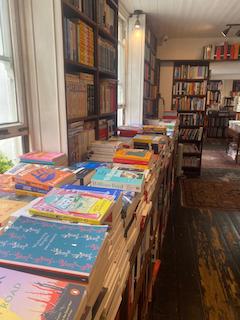Master's Diaries No. 1 - Sappho, lesbian musicology, and nuns, oh my!
by Sydney Minor
Dear Sinister Wisdom readers,
Let me take a second to re-introduce myself. I’m Sydney, the Sinister Wisdom Blog’s Curator. As part of the blog’s reboot, I’ll be launching a monthly series about how my master’s in musicology is going (more on that later). If you’d like to start a recurring series of your own, feel free to email blog@sinisterwisdom.org, we’re still open to pitches and submissions!
I’m starting my master’s in musicology in a week. Actually, when this post goes live, it’ll be my move-in day. Wish me luck! I’m studying musicology with particular research interests in 20th-century opera, queer/feminist studies, horror, film, and how all those weird fun things can be intertwined. In this blog series, I might share a week in the life, an update on my dissertation, or dive into an interesting topic in queer musicology that I think you'd enjoy.
I thought a good place to start would be how I’ve been preparing over the summer to begin my master’s. A good portion of my summer has been spent researching: Sappho, lesbian musicology, and nuns, oh my!
What began as research for a Sinister Snapshot Featurette evolved into an article,then into a potential dissertation idea. Around July, I started looking into examples of lesbian poetry set to music. The most bountiful poet was Sappho, whose work has been set to music since the early 20th century. I spoke with our editor Julie, and she recommended I read Yopie Prins’ Victorian Sappho. The book went a bit over my head—I have no background in classics—but it turns out Prins also wrote an analysis of one of the pieces I was interested in. I devoured all this classical translation theory and started to think about how song cycles act as translations of text. In my opinion, research is most compelling when it intersects multiple art forms and disciplines. From there, I started thinking about how different musical settings of Sappho’s work depict lesbianism. Do they honor it, or distort it? I ended up writing an article for VAN Magazine about this, which came out last week. You can read it here.
The bad news is, once the article for VAN was accepted, I had to find another topic in lesbian musicology to write a Featurette on! During my Sappho research, I came across Elizabeth Wood’s Sapphonics, an academic article that asks, what makes music sapphic? I found it incredibly helpful and will most likely use it in my future research. It lays out a very clear framework for what can contribute to a lesbian essence in music. If you’re interested in learning more, check out my Featurette here.
Sapphonics comes from an anthology of queer musicology called Queering the Pitch. I’ve been slowly working my way through the book, taking notes and looking for further research inspiration. Another essay I found especially compelling was On a Lesbian Relationship with Music by Suzanne G. Cusick. Like Wood, she explores how lesbian sexuality can be understood through musicology, but her approach is more rooted in queer theory and politics than in musical analysis. Instead of proposing a specific lesbian aesthetic, she focuses on how the listener’s relationship with music can mirror a queer relationship.
What struck me most, though, was the essay’s form. It’s written as a personal essay, complete with anecdotes and first-person pronouns, something you don’t often see in academic writing. The topic itself also has a subversive edge. She poses questions like, how can a piece of music make love to you? Looking at the term “queer” from an etymological standpoint—meaning anything non-normative or deviant—the essay itself is queer, simply by rejecting traditional academic structure. I love this idea and would love to incorporate it more into my own writing.
The last part of my Summer Research Journey actually had nothing to do with music, but instead focused on nuns and the gothic. When I got access to my new university’s library system, it felt like Christmas morning. I suddenly had way more resources than I was used to, having gone to a conservatory for undergrad. I immediately began downloading books and articles related to my broader interests and stumbled upon Rethinking Gothic Transgressions of Gender and Sexuality. How interesting!
My undergraduate dissertation was on Strauss’ Salome (1905) and how it can be analyzed through the lens of Barbara Creed’s, “monstrous-feminine.” There’s a chance I’ll continue down this path for my diss, so the chapter titled From Gothic Heroines to Monstrous Prom Queens: Gender Horror in Dracula and Jennifer’s Body felt like a must-read. Honestly, nothing groundbreaking was said—queerness is transgressive and scary because it subverts the patriarchy, yes, we know—but it was still a fun read.
On a similar gothic note, I’ve been really into nuns lately. I’ve joked before that in a past life I was probably a sexually-repressed, closeted-nun, but that’s a story for another time. The nunsploitation genre—a film and literary subgenre portraying convents as hotbeds of lesbianism and perversion (ah, the horror!)—actually has a surprising amount of screentime in opera. There are many operas about nuns, including Suor Angelica (1917), Dialogues des Carmélites (1953), Sancta Susanna (1921), and The Fiery Angel (1927). I’m really interested in analyzing these operas through this lens, especially in terms of how the music contributes to the message.
I haven’t found much academic writing on this topic, so if you have any ideas or resources, I’d be extremely appreciative. Just email blog@sinisterwisdom.org!
That’s all for now, until next time, folks!
With love,
Sydney
References
Brett Wood Thomas’ Queering the Pitch
Barbara Creed’s The Monstrous-Feminine: Film, Feminism, Psychoanalysis
Rethinking Gothic Transgressions of Gender and Sexuality: New Directions in Gothic Studies edited by Sarah Faber and Kerstin-Anja
Salome (1905)
Suor Angelica (1917)
Dialogues des Carmelites (1953)
https:/Sancta Susanna (1921)
The Fiery Angel (1927)
Sydney Minor (she/her) is a New York-born, London-based writer and musician currently pursuing an MPhil in musicology at Cambridge. You can find more of her ramblings regarding music, art, and culture on her Substack, Salome’s Veil.

"Empowerment comes from ideas."
― Charlene Carruthers
"Your silence will not protect you."
— Tourmaline
"Gender is the poetry each of us makes out of the language we are taught."
— Leila Raven


